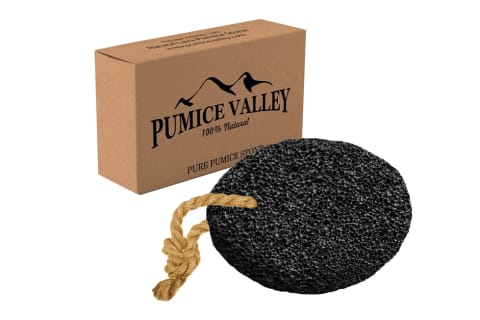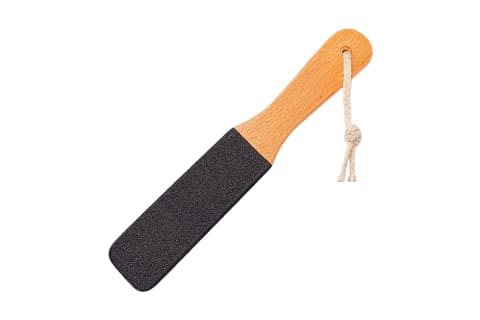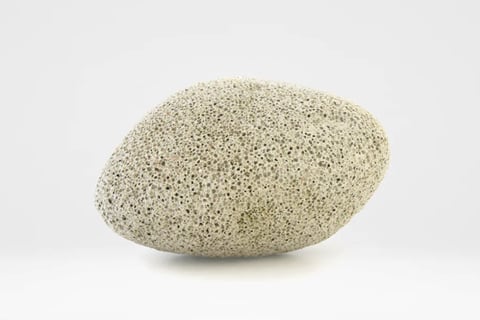Advertisement
How To Use A Pumice Stone, From The Pros + What Not To Do

You don't have to love feet to know that it's important to take care of them. Not only should you schedule a daily walk and wear high-quality shoes while you do so, but the skin on your feet could probably use some TLC, too.
One key to optimizing your foot skin care routine (yes, it's a thing) is exfoliation. You may have a pumice stone lying around the house somewhere, but do you actually know how to use it? Keep reading if the answer is no, maybe, or I thought so.
What is a pumice stone?
Pumice stones form when lava and water mix together—when the lava cools rapidly, it creates a porous, foamy-looking texture that happens to be great for removing dry and dead skin cells.
And because of their natural makeup, no surprise pumice stones have been used as an ancient remedy for exfoliation—even as far back as 100 B.C. There's a good reason pumice stones have left their mark for more than 2,000 years; they're super light yet abrasive enough to lift dead skin cells and smooth out the texture.
You won't want to use pumice stones on your face, though, as they're far too abrasive. For facial exfoliation, opt for a gentle scrub, enzymes, or chemical exfoliants like AHAs and BHAs. These stones are reserved for calloused areas or the feet.
How to use a pumice stone.
Now you know where to use them, but how you do so will make all the difference. See, these powerful exfoliators aren't something to mess around with, and using them improperly can literally rub your skin raw—so remember these tips:
Soak your feet or hands before.
Again, you can follow these steps for feet or hand calluses or corns—but that's it. Before you start, dip your designated area in warm water. "You will see better results if you soak your feet before using a pumice stone," medical aesthetician and founder of JTAV Clinical Skincare Joie Tavernise tells mbg.
"Your skin should be moist and soft to the touch but not wrinkly from long exposure to water," she clarifies. Be sure to make your foot bath a medium to warm temperature, as burning hot water will only irritate the skin.
About five minutes will do, board-certified dermatologist and founder of Visha Skincare, Purvisha Patel, M.D., notes. After your foot soak is finished, you'll go in with the pumice stone on clean, damp skin (read: skip the towel dry).
Exfoliate.
Now it's time to use your stone. Rub the stone in circular motions over the area; a medium pressure is more than enough to remove the dead skin cels. If you're working on your hands, Tavernise recommends using very light pressure, as this area is more sensitive than the feet.
When you're exfoliating, you might even see dead skin cells visibly accumulate on the stone (gross but strangely satisfying). Because this can get messy, it's best to complete this step over a bath or while you're in the shower (just don't fall when balancing on one leg).
Be sure to stop when you've reached a desired smoothness (about two to three minutes does the trick, board-certified dermatologist and founder of MMSkincare Ellen Marmur, M.D., says), or when the dead skin cells stops clinging to the pumice stone's pores.
If you're working on calluses or corns, proceed with caution and don't eliminate them completely "Calluses exist to protect our feet in areas of high friction, so use moderation when attempting to file them down," board-certified dermatologist Rebecca Marcus, M.D., FAAD, tells mbg. Corns develop due to bone pressure on the skin, creating a more padded area of the skin.
Some people may be able to use a pumice stone every other day, while plenty of others can only tolerate it once a week or once every other week—it all depends on how sensitive your skin is. Start with weekly use and see how you feel—if your skin is sore, dial it back. If your skin continues to dry out or you build calluses quickly, use it every few days, and so on. You can also alternate using a pumice stone and other ways to exfoliate feet.
Dry and moisturize.
After all that exfoliating, you'll want to add moisture back into the skin. After towel-drying your skin, apply a thick cream to seal in any micro-cracks. "Since the manual exfoliation of the stone can cause microabrasions on the skin, it's important to apply moisturizer to help repair the small cracks in the skin from the pumice exfoliation," explains Patel.
Look for a body lotion or foot cream with barrier-loving ingredients, like some of these:
- Ceramides
- Peptides
- Shea butter
- Aloe vera
- Hyaluronic acid
- Botanical oils
- Mango seed butter
- Avocado butter
- Coconut oil
Pro tip:
Pumice stone don'ts.
Again, pumice stones are not a harmless tool, and they should be used with caution. Keep these no-no's in mind:
- Don't use it anywhere besides hand calluses and on the feet.
- Don't use an exfoliating serum afterward.
- Don't use pumice stones on dry skin.
- Don't share your pumice stone with another person.
- Don't forget to moisturize after.
- Don't use your pumice stone on already sore feet.
- Don't continue use if your feet turn red or itchy.
Pro tip
Best pumice stones
How to clean a pumice stone.
"You want to make sure to keep the pumice stone clean because the built-up skin cells can act as a fomite and harbor bacteria that can be passed back to your skin or other areas on the body during its next use," board-certified dermatologist Nava Greenfield, M.D., explains.
To do so, pop your pumice stone in a bowl of warm water and antibacterial soap, Greenfield says. You can add a bristle brush to your cleaning routine if you find your pumice stone has larger holes that catch more dead skin cells.
"Another alternative would be to soak the stone in a diluted bleach or vinegar solution to kill bacteria," Marcus notes. She recommends doing this soak once every few weeks if you regularly use your pumice stone. If it's an occasional tool you pull out, then just be sure to clean it after every use.
Why your feet get cracked & dry.
If you're using this tool regularly and want to know why your feet just won't stay smooth, scan these possible causes or check out this deep dive for more information:
- Eczema or psoriasis
- Extra-hot showers
- Walking barefoot
- Harsh soaps
- Aging skin
- Diabetes
- Overall dehydration
- Lack of topical hydration
- Vitamin deficiencies
FAQ
Do you use a pumice stone wet or dry?
Wet your pumice stone before use, then rub it on clean, wet skin. Rubbing this stone on dry skin will result in tugging and potential irritation. Consider soaking your feet for a few minutes before going in with your pumice stone.
Where should you not use a pumice stone?
Do not use a pumice stone anywhere besides the bottom of your feet or on stubborn hand calluses. The exfoliation is too strong for gentle areas like the rest of the body and especially the face. If you use it on the body or face, it may result in irritation, redness, and a damaged skin barrier.
How often should you use a pumice stone on your feet?
Some people may be able to use a pumice stone every other day, while some may have too sensitive of skin to tolerate frequent use. As a rule of thumb, use a pumice stone when you begin to notice calluses or buildup of dry skin, and discontinue or spread out the use if you notice redness or irritation.
The takeaway.
Foot care is often overlooked but is still an important part of a full-body self-care routine. If you tend to get calluses or notice dead skin building up on your feet, a pumice stone can work wonders to reveal fresh new skin within a few minutes. Remember to only use this tool on hand calluses or on the feet, and never rub too hard. Want more ideas to slough off dead skin from your feet? Consider a DIY foot scrub—here's the how-to.



